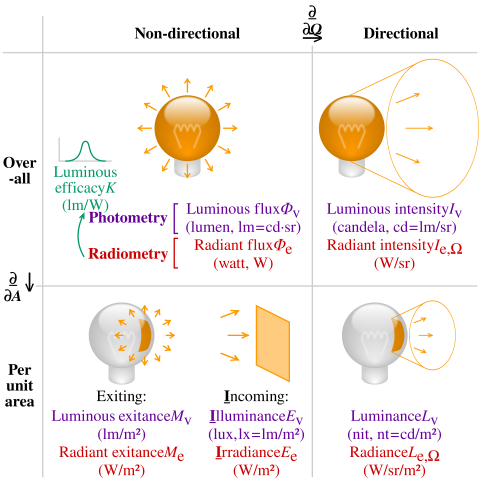Difference between revisions of "3D Technologies and Solutions"
m |
m |
||
| (5 intermediate revisions by the same user not shown) | |||
| Line 30: | Line 30: | ||
[[File:photometry radiometry units.png|480px]] | [[File:photometry radiometry units.png|480px]] | ||
=== LookdevKit === | |||
A plugin for Maya which provides some useful shader nodes: math, noise, mix, etc. | |||
=== LookdevX === | |||
A node-based material editor for USD assets which comes with Maya. | |||
Not to be confused with LookdevKit. | |||
=== LTC === | === LTC === | ||
Linearly transformed cosines, a set of distributions to render area lights. | Linearly transformed cosines, a set of distributions to render area lights. | ||
=== MaterialX === | |||
Standard for interoperable node-based materials. MaterialX graphs can be stored inside USD assets or as separate XML (.mtlx) files. | |||
=== Mental Ray === | === Mental Ray === | ||
| Line 52: | Line 66: | ||
Not to be confused with OpenSceneGraph (OSG). | Not to be confused with OpenSceneGraph (OSG). | ||
=== OpenPBR Surface === | |||
Name of standard shader node used for physically based rendering (PBR). Supported starting from 3ds Max 2025.3 and Maya 2025.3. | |||
=== PMREM === | |||
Stands for prefiltered mipmapped radiance environment map. A special map which is used to calculate image-based lighting for PBR-based materials. | |||
=== Radiance === | === Radiance === | ||
Latest revision as of 11:44, 18 October 2024
This article describes some terms and solutions used in 3D visualization industry.
ART
Autodesk RayTracer, physically-based render engine for 3ds Max, AutoCAD, Revit, etc. Uses path tracing on CPUs for rendering.
ATF
Autodesk translation framework, framework for data exchange.
BRDF
Bidirectional reflectance distribution function.
BSDF
Bidirectional scattering distribution function. Used as generalization for reflectance and transmittance, e.g. BSDF = BRDF + BTDF.
BTDF
Bidirectional transmittance distribution function.
Hydra (HD)
Framework to transport live scene graph data to renderer (originally USD to OpenGL render engine). Open source, developed by Pixar.
Irradiance
Radiant flux received by a surface per unit area. The unit of irradiance is the watt per square metre (W⋅m−2).
LookdevKit
A plugin for Maya which provides some useful shader nodes: math, noise, mix, etc.
LookdevX
A node-based material editor for USD assets which comes with Maya.
Not to be confused with LookdevKit.
LTC
Linearly transformed cosines, a set of distributions to render area lights.
MaterialX
Standard for interoperable node-based materials. MaterialX graphs can be stored inside USD assets or as separate XML (.mtlx) files.
Mental Ray
Deprecated ray tracing renderer by NVIDIA. Was used in older versions of 3ds Max, Maya, Revit, Softimage, etc. Replaced by Arnold.
MetaSL
Outdated shading language which was used in 3ds Max (before 2016) and Mental Mill software.
Nitrous
3ds Max viewport system.
OGS
Open graphics system, viewport renderer used in Autodesk software (3ds Max, Maya, AutoCAD, Inventor, Revit, Fusion, Infraworks, Navisworks, Recap, etc).
Not to be confused with OpenSceneGraph (OSG).
OpenPBR Surface
Name of standard shader node used for physically based rendering (PBR). Supported starting from 3ds Max 2025.3 and Maya 2025.3.
PMREM
Stands for prefiltered mipmapped radiance environment map. A special map which is used to calculate image-based lighting for PBR-based materials.
Radiance
Radiant flux emitted, reflected, transmitted, or received by a given surface, per unit solid angle per unit projected area. The unit of radiance is watt per steradian per square metre (W·sr−1·m−2).
RapidRT
Another name for Autodesk RayTracer renderer (ART).
Stingray
A discontinued 3D game engine. Also known as 3ds Max Interactive. The shader node system based on Stingray PBS is still supported in 3ds Max, Maya (created via ShaderFX editor).
